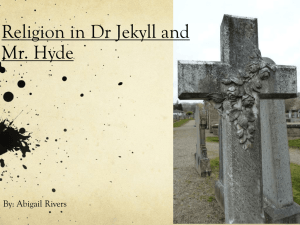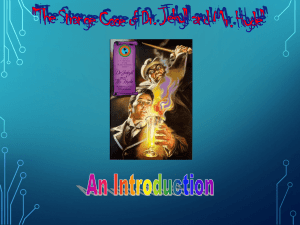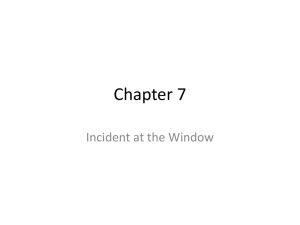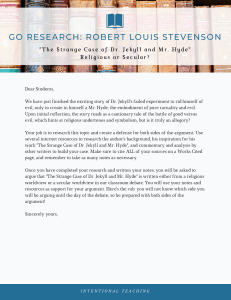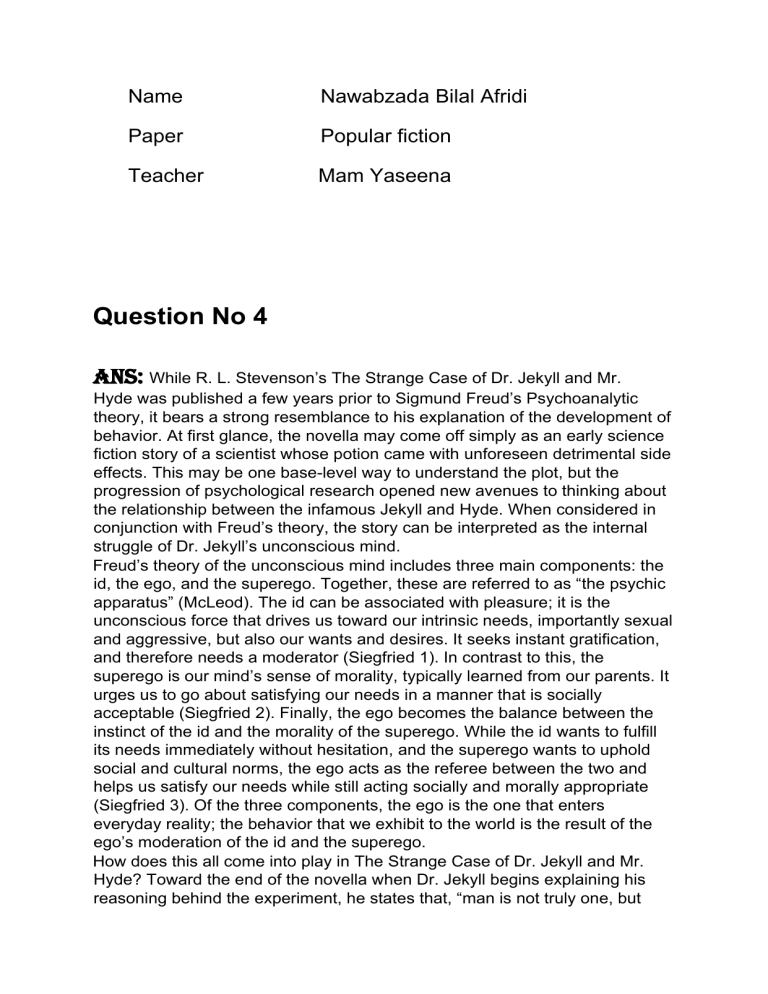
Name
Nawabzada Bilal Afridi
Paper
Popular fiction
Teacher
Mam Yaseena
Question No 4
ANS: While R. L. Stevenson’s The Strange Case of Dr. Jekyll and Mr.
Hyde was published a few years prior to Sigmund Freud’s Psychoanalytic
theory, it bears a strong resemblance to his explanation of the development of
behavior. At first glance, the novella may come off simply as an early science
fiction story of a scientist whose potion came with unforeseen detrimental side
effects. This may be one base-level way to understand the plot, but the
progression of psychological research opened new avenues to thinking about
the relationship between the infamous Jekyll and Hyde. When considered in
conjunction with Freud’s theory, the story can be interpreted as the internal
struggle of Dr. Jekyll’s unconscious mind.
Freud’s theory of the unconscious mind includes three main components: the
id, the ego, and the superego. Together, these are referred to as “the psychic
apparatus” (McLeod). The id can be associated with pleasure; it is the
unconscious force that drives us toward our intrinsic needs, importantly sexual
and aggressive, but also our wants and desires. It seeks instant gratification,
and therefore needs a moderator (Siegfried 1). In contrast to this, the
superego is our mind’s sense of morality, typically learned from our parents. It
urges us to go about satisfying our needs in a manner that is socially
acceptable (Siegfried 2). Finally, the ego becomes the balance between the
instinct of the id and the morality of the superego. While the id wants to fulfill
its needs immediately without hesitation, and the superego wants to uphold
social and cultural norms, the ego acts as the referee between the two and
helps us satisfy our needs while still acting socially and morally appropriate
(Siegfried 3). Of the three components, the ego is the one that enters
everyday reality; the behavior that we exhibit to the world is the result of the
ego’s moderation of the id and the superego.
How does this all come into play in The Strange Case of Dr. Jekyll and Mr.
Hyde? Toward the end of the novella when Dr. Jekyll begins explaining his
reasoning behind the experiment, he states that, “man is not truly one, but
truly two”, and that he “was radically both” (Stevenson 1809), referring to the
good and the evil that resides inside of him. He struggled with the ability to
hold back his instinctive pleasures, so he dreamt of separating his good,
moral self, from his compulsive, evil self. The struggle going on inside him can
be related to the extremities of the id and the superego clashing against one
another without the ego there to appropriately balance the two.
The superego in this equation can be represented by society itself. Jekyll’s
whole struggle in life is the need to hold back from his urges in order to
present himself positively to the public. Being born “to a large fortune” and
“inclined by nature” (Stevenson 1808), Jekyll from the start was set up to be in
a public spotlight, forcing him to practice good morals and ethics at all times.
The ego’s job is to find an even balance between inward desires and outward
appearance, but because of his status, he needed to suppress his id more
often than set aside his superego’s morality. He says, “I for my part, and the
nature of my life, advanced infallibly in one direction and in one direction only.
It was on the moral side, and in my own person, that I learned to recognize
the thorough and primitive duality of man” (Stevenson 1809). As he continued
satisfying his moral superego, his instinctive id became in need of an outlet for
expression.
The Jekyll side of him can obviously be seen as the ego, making an effort to
control his primal tendencies in conjunction with the expectations of society.
He describes his outward self as, “good among my fellow men”, and as
having, “every guarantee of an honorable and distinguished future”
(Stevenson 1808-9), showing his ability to perform morally and controlled in
society. Complying with cultural and societal norms is the primary job of the
superego, and he fulfills this duty when he is himself. Jekyll comes off as a
typical character in the book because he embodies the ego, keeping his
desires and tendencies in check just like any other person. He also has the
ability to give in to the pleasures the id seeks by turning himself into Hyde, just
as the ego has the power to lean toward one side or the other.
Mr. Hyde, however, is much different than Dr. Jekyll. Those who have seen
Hyde describe him as “particularly wicked-looking” (Stevenson 1791),
embodying the aggressive tendencies of the id. His actions speak for
themselves when he tramples “calmly over [a] child’s body” (Stevenson 1781),
and beats a man to death with his cane (Stevenson 1790), holding true to the
impulsive and aggressive tendencies of the id. Just like the id, Mr. Hyde has
neither constraint nor remorse for his actions, as he seeks only to satisfy his
urges. As Dr. Jekyll, he must “conceal [his] pleasures” (Stevenson 1809), but
Hyde is his relief from this. The “duality of man” (Stevenson 1809), Jekyll
comes to notice from his excessive amount of time satisfying his superego
becomes literal when he takes the form of Hyde.
When taking Freud’s theory of the unconscious mind into consideration while
reading The Strange Case of Dr. Jekyll and Mr. Hyde, the story begins to take
on a new, symbolic form of the mind’s struggle to create behavior. This may
not be what was intended by R. L. Stevenson when he wrote the novella, but
the knowledge of this psychological theory can change the reader’s reception
of its underlying meaning. The struggle Dr. Jekyll faces between the need to
comply with societal rules and the need to satisfy impulses is a very real one
that every person unconsciously deals with before actively displaying a
behavior. Freud’s theory takes this story to a more realistic level, and offers a
guide for readers to deeper interpret its message of human duality.
Q no 3{a}
Ans:
Stevenson keeps the readers interested by using the
supernatural and horror side of things to make it scary because when
the story first came out they weren’t used to scary stories. He also uses
mysteries to keep the readers wondering, guessing and wanting to know
more. He includes moral messages in the story to keep people/the
readers questioning themselves wondering if they are more similar to
Mr. Hyde than they think.
Stevenson sets all the action in the story during the
night. He does this because the night is dark and concealing which
explains the reason why Stevenson chose to place the action in his story
during the night. Stevenson uses the windows as a symbol to suggest
that the secrets and events happening are being hidden but also being
watched. Most of the darker events happen through windows/doorways.
“Mr. Hyde broke out of all bounds, and clubbed him to the earth.”
A woman witnessed Hyde beating a gentleman to the
ground from a window this is a darker and more graphic thing for
someone to see. That incident happened during the night, which makes
the murder seem all the more dark and evil. Mr. Utterson hears about
Mr. Hyde from Enfield in a gossipy way and decides to seek this man
out. He does this not only because of the gossipy information he got
from Enfield but because he is suspicious of Dr. Jekyll’s will. “If he be
Mr. Hyde, he had thought,’ I shall be Mr. Seek’ ” This is a pun as he is
going to Mr. Hyde. Mr. Utterson then stakes out and paces around the
area that Mr. Hyde was supposedly in from the gossip he heard. “Mr.
Utterson began to haunt the door in the by street of shops.” The ‘haunt’
is as if he’s like a ghost hoveri... ... middle of paper ... ...trol over Hyde.
“...Mr. Hyde broke out of all bounds, and clubbed him to the earth.” It
sounds like Mr. Hyde just lost control and attacked this man.
Dr. Jekyll is kind and far too nice to lose control and beat
a man to the ground so this is definitely showing him losing control over
Hyde. Stevenson uses a combination of: horror, supernatural, moral
messages, and mysteries. The use of horror captures us because it’s
normally shocking and frightening to think about. When you combine
that with mystery you get an effect that makes you feel edgy and
nervous to read on but you want to read on because if you don’t you’ll
never get the answers to your questions. His uses of moral messages is
effective in keeping the reader’s interest because it will make the reader
question and doubt themselves on things because they might feel more
like Hyde than they would like to.
Q no 3 {b}
ANS’ GHOTHIC NOVEL Gothic fiction, sometimes called Gothic
horror in the 20th century, is a genre of literature and film that
covers horror, death and at times romance. It is said to derive from the
English author Horace Walpole's 1764 novel The Castle of Otranto, later
subtitled "A Gothic Story". Early contributors included Clara Reeve, Ann
Radcliffe, William Thomas Beckford and Matthew Lewis. It tends to
stress emotion and a pleasurable terror that expands the Romantic
literature of the time. The common "pleasures" were the sublime, which
indescribably "takes us beyond ourselves."[1] Such
extreme Romanticism was popular throughout Europe, especially among
English and German-language authors.[2] Its 19th-century success
peaked with Mary Shelley's Frankenstein and work by E. T. A.
Hoffmann, Edgar Allan Poe and Charles Dickens, and in poetry
with Samuel Taylor Coleridge. Also prominent was the
later Dracula by Bram Stoker. The name Gothic spread from
the Goths to mean "German".[3] It also draws in Gothic architecture of
the European Middle Ages, where many of the stories occur. Twentiethcentury contributors include Daphne du Maurier, Stephen King, Shirley
Jackson, Anne Riceand Toni Morrison.
1. Set in a haunted castle or house
The main location, usually an old castle plagued by an ancestral curse,
is a vital element in Gothic fiction, providing a dark and threatening backdrop.
Horace Walpole was avidly interested in medieval architecture,
transforming his villa into a castle, complete with turrets and towers.
2. A damsel in distress
The female lead often face events that leave them terrified, screaming
and fainting. Returning to her medieval role as damsel in distress, the
virtuous heroine is typically incarcerated in a castle and pursued by a
sadistic aristocrat. Early examples in this genre include Matilda in
Horace Walpole’s ‘The Castle of Otranto’ and Emily in Ann Radcliffe’s
‘The Mysteries of Udolpho.’
3. An atmosphere of mystery and suspense
The work is pervaded by a threatening feeling, a fear enhanced by the
unknown. When first published, Wilkie Collin’s ‘The Woman in White‘
was identified as a “sensational novel.” The story involves family secrets,
faked identities, and false imprisonment.
4. There is a ghost or monster
In Mary Shelley’s ‘Frankenstein‘, Victor Frankenstein creates a monster
using body parts from deceased criminals in an attempt to make the
perfect human being. Other main characters have included supernatural
or grotesque creatures, ranging from vampires, devils, ghosts, monsters,
demons, zombies to evil spirits, the “possessed,” and werewolves
5. The weather is always awful
Flashes of lightning accompany revelation and thunder and downpours
usually prefigure the appearance of a character or the beginning of a
significant event. The storms and wind that sweep through ‘Wuthering
Heights‘ signify how the characters are at the mercy of forces they
cannot control. In ‘Rebecca’, the weather mirrors the characters’ moods;
a fog descends when the narrator, the second Mrs. de Winter is
confused and depressed.
6. Dreaming/nightmares
Fuseli, the quintessential Romantic artist is often quoted as saying, “One
of the most unexplored regions of art are dreams” and writers as diverse
as Walpole, Stoker and Shelley were all inspired by vivid and unsettling
nightmares.
7. Burdened male protagonist
Aristocratic, suave, moody, solitary, cynical and nursing a guilty secret,
this darkly attractive and conflicted male figure surfaces everywhere in
Gothic fiction. Both Maxim in ‘Rebecca’ and Mr.Rochester in ‘Jane
Eyre‘ are tormented by their pasts and both their ancestral homes go up
in flames.
8. Melodrama
Emotions run high in Gothic literature reflecting a heightened sense of
drama. Women have a tendency to swoon and men rage in reflection of
unseen inner torments. There are also murders, kidnappings and
people going mad. The villain is usually the central character but fate
intervenes in the end to ensure good triumphs over evil.
9. Death
The Gothic novel is enthralled with death and the supernatural
contributing to an atmosphere of horror. If Gothic literature reflects a
wish to overcome one’s mortality, there is also a fear of those who
somehow manage to transcend it; i.e. vampires, whom are at once both
dead and alive.
10. The beast within
Robert Louis Stevenson’s ‘Strange Case of Dr Jekyll and Mr Hyde‘
(1886) tapped into contemporary anxieties. Dr Jekyll is eminently
respectable while Mr. Hyde is brutal and ape-like. The twist is that both
represent two facets of the same person.
DETECTIVE NOVEL:
Detective fiction is a subgenre
of crime fiction and mystery fiction in which an investigator or
a detective—either professional, amateur or retired—investigates a
crime, often murder. The detective genre began around the same time
as speculative fiction and other genre fiction in the mid-nineteenth
century and has remained extremely popular, particularly in
novels.[1] Some of the most famous heroes of detective fiction
include C. Auguste Dupin, Sherlock Holmes, and Hercule Poirot.
Juvenile stories featuring The Hardy Boys, Nancy Drew, and The Boxcar
Children have also remained in print for several decades.
Q no 4
Answer: The setting for Dr Jekyll and Mr Hyde is Victorian London,
which was in many ways a very different place from the city we know
today. Many people believe that Stevenson transposed his tale to
London in order to gain wider appeal, but that he had his native
Edinburgh in his mind. Dickens had already achieved great success by
setting several of his novels in London, and Conan Doyle would go one
step further by incorporating several real London venues into his
Sherlock Holmes stories, published a year after Dr Jekyll and Mr Hyde.
London clearly seems to have been a winning formula for literary
success.
From the 1850s to the turn of the century, British
society outwardly displayed values of sexual restraint, low
tolerance of crime, religious morality and a strict social code of
conduct.
For the middle class in the 19th century, the family
unit and all it stood for was the most important institution in
England. Middle class morality and values were all important piano legs were called limbs ("legs" was considered an improper
word), gambling became a sin, and certain things were considered
"not proper". The home and family were sacred, hard work and
perseverance were encouraged, and a stiff authoritarianism
controlled those who might question "the system".
In many ways, the Victorians were hypocrites
because they claimed to be moral and pious in ways they were
not. They shut their eyes to whatever was ugly and unpleasant
around them. In some way, perhaps they hoped to draw attention
away from their own hypocrisies by pointing out the hypocrisies in
others. The pious nature of Victorian society meant that many
people suppressed their desires and feelings. This resulted in
many people questioning their 'goodness' as a human being due to
the fact that religion condemned these 'evil' thoughts.
The nineteenth century was a time of huge social,
scientific and technological change and with that change came an
increase in crime and many social problems. It was the beginning
of the Industrial Revolution, which transformed England from a
mainly rural economy to an industrial one, with thousands of poor
country-folk flocking to the cities in search of work. Foundries and
factories were emerging on an unprecedented scale, and effluent
and raw sewage were being pumped into the River Thames.
Without an infrastructure to support them, many people were
forced to live in unsanitary and overcrowded conditions.
The alleys and courts of the city were dark and dirty;
pollution gave rise to smoke and fog, often associated with crime
and degeneracy. Stevenson uses Chapter 4 ‘The Carew Murder
Case’ in particular to raise awareness of this, when Utterson takes
Inspector Newcomen to Hyde’s house at nine in the morning:
Night was seen as a time of lawlessness, mystery and
fear. In Dr Jekyll and Mr Hyde light and dark are used very
effectively to create atmosphere and reveal character. The two
violent episodes – the trampling of the small girl and the murder of
Danvers Carew – both take place either late at night or in the early
hours of the morning, illuminated by either numerous street lamps
(which would be much less bright and more yellow than we are
used to today) or a full moon.
Q no 6
Answer’ Full Title
And Then There Were None (originally
published as Ten Little Indians)
Author
Agatha Christie
Type Of Work
Novel
Genre
Murder mystery
Language English
Time And Place Written 1939, England
Date Of First Publication 1939
Publisher G. P. Putnam’s Sons
Narrator The narrator is an unnamed omniscient individual.
Point Of View
The point of view constantly shifts back and forth
between each of the ten characters.
Tone
The narrator relates the story in a dark, foreboding, and
sinister tone, and often reacts dramatically (or melodramatically) to
the events of the story.
Tense
Past
Setting (Time) 1930s
Setting (Place) Indian Island, a fictional island off the English
coast
Protagonist
Although no clear protagonist exists, Vera
Claythorne and Philip Lombard are the most fully developed
characters, and they outlive almost everyone else.
Major Conflict
An anonymous killer gathers a collection of
strangers on Indian Island to murder them as punishment for their
past crimes.
Rising Action
The accusations made by the recorded voice turn
the island getaway into a scene of paranoia; the murders of Tony
Marston, Mrs. Rogers, General Macarthur, Mr. Rogers, and Emily
Brent indicate that no one will be able to escape the “Ten Little
Indians” rhyme.
Climax
The apparent death of Judge Wargrave and the
disappearance of Dr. Armstrong strip away any sense of order.
Falling Action
The murders of Blore, Lombard, and Vera,
combined with Wargrave’s confession, restore some sense of
order to the chaos of the story.
Themes
The administration of justice; the effects of guilt on
one’s conscience; the danger of reliance on class distinctions
Motifs
The “Ten Little Indians” poem; dreams and
hallucinations
Symbols The storm; the mark on Judge Wargrave’s forehead;
food
Foreshadowing Vera’s first sight of Indian Island, which she
thinks looks sinister, hints at the trouble to come; the old man’s
warning to Blore on the train that the day of judgment is
approaching hints that Blore will soon die; the “Ten Little Indians”
poem lays out the pattern for the imminent murders; Vera’s
fascination with both the poem and the hook on her ceiling
presage her eventual decision to hang herself.
The end
